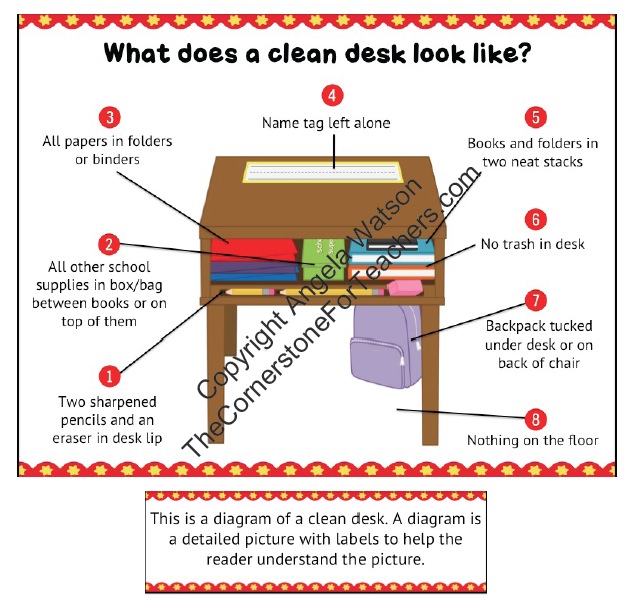When I taught third grade, I found I’d often ask the kids to clean up their desks only to have them look at me quizzically and reply, “I did!” I would peer into their desks and see bits of crayon wrapper, balled up pieces of paper, and mountains of broken pencils piled on top of crooked stacks of books and exclaim, “Does this look clean to you?” The kids would stare at me blankly, move some things around, and then show me a desk three seconds later that looked only marginally better.
That’s when I realized that MY expectations for a clean desk were completely different than the KIDS’ expectations. And it was time I figured out a way to get us on the same page.
Since my class was already learning about text features, I decided to incorporate some literacy skills by making a diagram. I drew this clean desk diagram and hung it up at the front of the room:

I then introduced my expectations in a mini lesson which taught students how to use the diagram to clean their desks and check to see if their desks were clean. I encouraged them to figure out the reason why each aspect of the diagram was included and how it would help them to find and care for their materials more easily.
After the introductory mini lesson, I’d conduct periodic desk checks. These weren’t done in a crazy drill sergeant way–they were actually fun for the kids because I’d made cleaning up into a game, and the kids were anxious to see if their desks would match up to the diagram and pass inspection. We had a lot of fun with it! The first desk check I did was usually later the same day that I taught the mini lesson so students’ desks were still fairly neat and it wouldn’t take long. I modeled how to do a desk check by reading each element and checking a student’s desk to see if it matched, narrating my thoughts as I went: “Let’s see…#1…two pencils and an eraser…nope, I only see one pencil, so let me get another out of the supply box. Okay, now #1 matches. #2…all supplies in the pencil box which should be on top of the books or between the stacks, yep, got that…#3…” and so on. Then I gave students about one minute to read each element on the diagram and check their desks in the same way.
The clean desk diagram worked wonders in terms of making sure kids understood exactly what was expected. But of course, the kids didn’t automatically keep their desks clean just because I’d shown them how! They needed reminders and practice opportunities all throughout the year. I usually conducted desk checks once a day at the beginning of the school year and once a week for the rest of the year. The good news is that the “desk checks” became quicker and more efficient as students become familiar with the clean desk criteria and begin to internalize it. As students learned how to care for and organize their belongings, they realized their supplies lasted longer and were easier to find. My hope is that students will continue to see the value in organization and carry those skills all throughout their lives.
Since posting the photo (above) of my hand-drawn clean desk diagram on my website in 2005, I’ve gotten numerous requests to create a printable version. I’m excited to share that the fabulous Ashley Hughes of The School Supply Addict has offered to make student desk graphics for me so I could create ready-to-use diagram signs! Here’s one of my finished products:
I used the desk images created by Ashley to create 8 different diagrams. They’re the same basic image, but incorporate different terminology and expectations (some don’t have the backpack in them, some don’t mention the name tag, others use “desk edge” instead of “desk lip”).
You can download all 8 printable versions of the clean desk diagram as well as a two page mini lesson that gives you ideas for what to say when introducing the diagram to your students. Everything is available at my TeachersPayTeachers store. Click here to get it, and download the freebies in my store while you’re there.

Angela Watson
Founder and Writer
Sign up to get new Truth for Teachers articles in your inbox
OR

Join our
community
of educators
If you are a teacher who is interested in contributing to the Truth for Teachers website, please click here for more information.

















Discussion